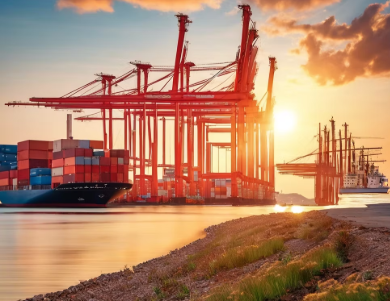How to Effectively Monitor Port Performance for Optimized Logistics

TL;DR
Port performance monitoring helps logistics teams track key metrics like container dwell time, vessel turnaround, and gate processing to reduce delays and avoid extra charges. With Vizion’s real-time data and port activity insights, teams can monitor port performance more effectively, streamline operations, and plan smarter routes.
Introduction
Port delays can derail supply chain timelines, increase detention charges, and disrupt delivery commitments. With port congestion and international shipping complexity rising, logistics professionals are under pressure to improve predictability and minimize disruption.
In 2023, waterborne vessels were the top mode of transport for U.S. international trade, carrying goods worth $2.1 trillion, which is about 41.5% of the total value of U.S. global trade. Of this, exports made up 35.5%, while imports accounted for 64.5%.
This is where port performance monitoring becomes essential. By tapping into accurate, real-time port activity data, logistics teams can proactively identify delays, plan better routes, and improve coordination. Using solutions like Vizion’s port activity datasets, you can now monitor port performance across key global hubs, track congestion, and manage throughput.
To fully understand how this works and what metrics matter, let’s break down what port performance monitoring actually entails and how it helps improve outcomes.
What Is Port Performance Monitoring?
Port performance monitoring refers to tracking, analyzing, and interpreting key operational indicators at container ports to ensure efficient cargo movement and minimize downtime. It enables logistics teams to:
- Understand how long vessels and containers dwell at specific ports
- Assess congestion and port throughput
- Evaluate port reliability over time
This allows for smarter routing decisions, better coordination with carriers, and improved customer service. By using structured, real-time datasets like those from Vizion, you can monitor port performance without relying on scattered, outdated updates.
Now that we understand the concept, let’s explore the key metrics logistics professionals should focus on when monitoring ports.
Key Metrics for Port Performance Monitoring
Monitoring the right metrics is essential to identifying potential delays and inefficiencies in your supply chain. The following indicators offer a comprehensive picture of port performance.
Vessel Dwell Time and Berth Utilization
Vessel dwell time measures how long a ship stays at port—from anchoring to departure. High dwell times signal congestion or operational inefficiencies.
Key benefits of tracking this metric:
- Assess average vessel turnaround time
- Identify ports with frequent congestion
- Choose ports with faster processing for high-priority shipments
Read Also: How to Perform a Fresh Concrete Density Test in the Field
Container Dwell Time and Terminal Congestion
Container dwell time measures how long a container sits at the port before being picked up or transferred. When this time is high, it can lead to demurrage charges and customer dissatisfaction.
Vizion’s port data helps you:
- Monitor real-time container dwell times
- Detect delayed pickups or transshipments
- Avoid avoidable storage costs and congestion risks
Gate Processing Time and On-Time Performance
Tracking gate-in/gate-out events provides insight into port efficiency at the truck interface. It also reveals trends in congestion and delays during pickup or delivery windows.
By monitoring:
- Average time for containers to enter/exit the terminal
- On-time delivery or pickup performance
- Patterns by day, time, or carrier
You gain better control over planning and downstream coordination.
With these metrics in hand, the next critical question is—how can you make these insights actionable? The answer lies in data freshness.
Why Real-Time Data Matters for Port Performance
Port operations change by the hour. Relying on weekly averages or delayed EDI feeds makes it difficult to react to disruptions before they escalate. That’s why real-time port performance monitoring is crucial.
Vizion offers real-time updates on:
- Vessel arrivals and departures
- Container gate events
- Terminal congestion alerts
These updates allow logistics professionals to monitor port performance dynamically, anticipate issues, and communicate ETAs with greater accuracy. Real-time visibility empowers teams to act immediately when delays are detected—mitigating risks and improving outcomes.
With this foundation, let’s look at how port data directly contributes to operational improvements.
How Port Performance Monitoring Drives Operational Efficiency
Once you begin tracking key port metrics in real time, the operational benefits are immediate and measurable. Here’s how port performance monitoring enhances logistics performance.
Reducing Delays and Avoidable Charges
Late pickups, unplanned holds, or long wait times can result in demurrage and detention charges. With real-time updates on container movement and port activity, teams can:
- Schedule pickups before free time ends
- Adjust trucking routes based on terminal congestion
- Alert customers when shipments are likely to be delayed
This translates to direct cost savings and smoother logistics flows.
Improving Coordination and Customer Service
Accurate port data helps align internal teams and external stakeholders. Instead of chasing information, operations teams can:
- Share live status updates with customers
- Improve internal planning for inventory or distribution
- Reduce back-and-forth with carriers or port authorities
The result? Faster decisions, better communication, and stronger customer confidence.
Supporting Data-Driven Routing and Planning
Over time, port performance trends can reveal patterns that help improve strategic planning. Vizion’s TradeView and port datasets enable you to:
- Benchmark port performance across geographies
- Select ports based on historical efficiency
- Plan better for peak seasons or trade surges
This kind of insight supports long-term growth while avoiding reactive decision-making.
Now that we’ve explored the benefits, let’s move into the “how”—what’s required to implement port monitoring effectively?
Implementing Port Performance Monitoring: Best Practices
Building a reliable port performance monitoring system involves more than just tracking spreadsheets or portal updates. Here are two strategic best practices to help you get started.
Integrating Port Data with Logistics Systems
Your port data should live where your team works—inside your ERP, TMS, or customer portal. Vizion’s port performance insights integrate directly into these tools, enabling:
- Event-driven workflows
- Custom alerts for dwell time spikes
- Unified dashboards for shipment tracking and port activity
Integration ensures port data contributes to real-time decisions, not just post-mortem analysis.
Using Analytics to Benchmark and Optimize Port Operations
Monitoring is just the beginning. Analytics allow teams to extract patterns, identify underperforming routes, and optimize shipping decisions.
Use Vizion’s tools to:
- Compare carrier dwell time across ports
- Identify terminal congestion trends
- Generate port scorecards for internal or customer use
These insights turn static reports into actionable strategy.
To see these ideas in action, let’s walk through a real-world application.
Case Example: Using Port Performance Data to Optimize Supply Chains
A U.S.-based logistics provider regularly shipped through two Pacific ports. One port consistently incurred high demurrage fees and long truck wait times.
By using Vizion’s data to monitor port performance, they identified that:
- Average container dwell time at Port A was 46 hours
- At Port B, it was 23 hours
- Truck appointment availability was 30% lower at Port A
Armed with this data, the team shifted a portion of shipments to Port B, resulting in:
- A 40% reduction in detention charges
- Improved on-time delivery for downstream customers
- Streamlined coordination with drayage providers
This example shows how simple insights when delivered in real time can translate to measurable improvements in cost and reliability.
FAQs: Port Performance Monitoring
Q1: What is port performance monitoring?
It refers to tracking and analyzing port operations (like vessel dwell, container dwell, and congestion) to improve shipping efficiency.
Q2: Why is real-time data important in monitoring ports?
Because port conditions change quickly. Real-time updates allow logistics teams to act immediately and avoid delays or unexpected charges.
Q3: How does Vizion help monitor port performance?
Vizion provides real-time datasets on port activity, customs clearance, and container movement—directly integrated into your logistics tools.
Q4: What metrics are most important to track?
Vessel dwell time, container dwell time, gate processing time, and terminal congestion are key indicators.
Q5: Can this data help avoid demurrage fees?
Yes. By acting on real-time dwell and gate status updates, teams can coordinate timely pickups and reduce unnecessary charges.
Conclusion:
Key Takeaways for Smarter Port Performance Monitoring
Monitoring port performance isn’t just about tracking numbers—it’s about creating a smarter, more proactive logistics operation. With tools like Vizion’s port datasets and TradeView, your team can:
- Monitor port performance in real time
- Reduce delays and avoid extra fees
- Improve communication and planning
- Benchmark efficiency across global ports
To start transforming your port operations, explore Vizion’s real-time port activity data or book a demo today.







